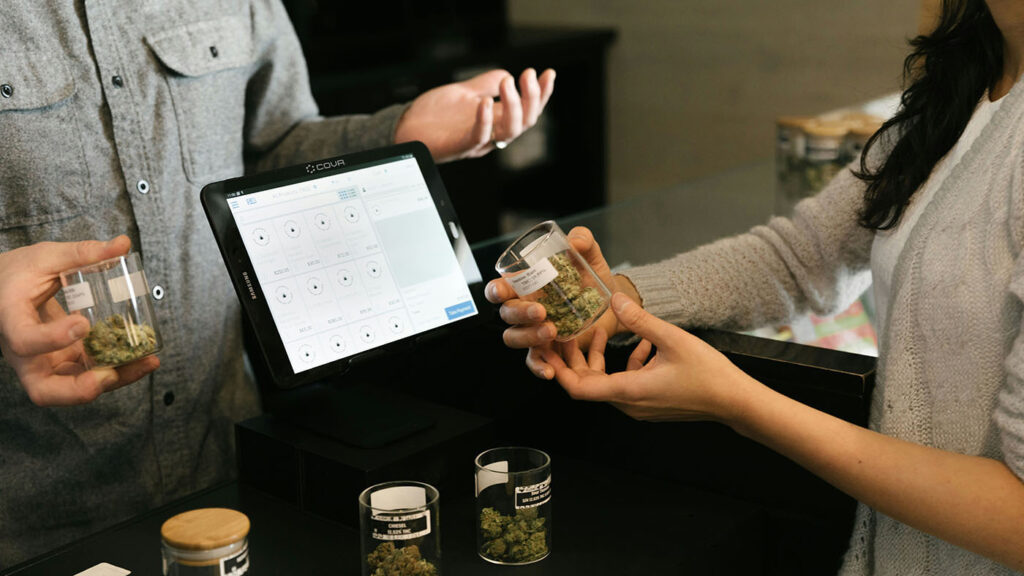Estimated reading time: 12 minutes
Table of contents
- Introduction
- Understanding Cannabis Distribution Channels
- Assessing Your Distribution Options
- Cannabis Dispensary Partnerships
- Decision Factors for Choosing the Right Distribution Channel
- Real-World Examples and Best Practices
- Actionable Steps to Develop Your Distribution Strategy
- Conclusion
- Cannabis Distribution Channels FAQs
- Additional Resources
- Free eBooks For Cannabis Business Success
- Latest Articles
Cliff Notes: Cannabis Distribution Channels
Objective: Develop a comprehensive strategy for cannabis distribution by evaluating retail storefronts, online sales, and dispensary partnerships.
Key Components:
- Decision Factors: Consider market demand, financial resources, regulatory environment, and competitive landscape.
- Cannabis Distribution Channels: Understand and select the right sales channels to reach your target market.
- Retail Cannabis Sales: Offers personalized experiences but involves high overhead.
- Online Cannabis Sales: Provides broad reach and lower costs, with regulatory challenges.
- Cannabis Dispensary Partnerships: Leverages established networks for increased credibility and market penetration.
- Mixed Distribution Models: Combine channels to diversify risk and maximize market reach.

Introduction
In the cannabis industry, choosing the right Cannabis Distribution Channels is vital to achieving business success. Whether you opt for a retail storefront, dispensary partnerships, online sales, or a mix of these methods, each channel offers distinct advantages and challenges. In this comprehensive guide, we will explore how to assess these channels, examine the pros and cons, and ultimately select the best fit for your cannabis business.
Understanding Cannabis Distribution Channels
A successful cannabis business must carefully select its Cannabis Distribution Channels to maximize market reach and profitability. These channels determine how your product reaches consumers and include various strategies such as retail storefronts, dispensary partnerships, and online sales. Transitioning smoothly between these options requires understanding each channel’s nuances and aligning them with your business goals.
What Are Cannabis Distribution Channels?
Cannabis Distribution Channels refer to the pathways through which cannabis products are sold to consumers. They are the critical touchpoints that connect your products with your target market. These channels include:
- Retail Storefronts: Traditional brick-and-mortar locations that provide an in-person shopping experience.
- Dispensary Partnerships: Collaborations with licensed dispensaries to sell your products.
- Online Sales: Digital platforms and e-commerce sites that enable consumers to purchase cannabis products via the internet.
- Mixed Channels: A combination of the above methods, which can leverage the strengths of each channel.
By understanding these different channels, you can make informed decisions that align with your business model and customer preferences.
Assessing Your Distribution Options
Choosing the optimal Cannabis Distribution Channels requires a thorough evaluation of your business goals, target market, and competitive landscape. Let’s dive into each distribution method, exploring the pros and cons and highlighting the key considerations for each.
Retail Cannabis Sales – Brick-and-Mortar Storefronts
Retail Cannabis Sales through physical storefronts have long been the traditional method for selling cannabis. This channel involves establishing a brick-and-mortar location where customers can visit, interact with staff, and make purchases in person.
Pros of Retail Cannabis Sales
- Personalized Customer Experience: Retail storefronts allow for face-to-face interactions. This personal touch helps build trust, answer customer queries in real time, and foster brand loyalty.
- Brand Visibility and Community Presence: A physical location can serve as a community hub, improving local brand recognition and providing opportunities for community engagement and events.
- Immediate Product Access: Customers enjoy the instant gratification of taking home their purchases immediately, which can be a significant selling point.
- Enhanced Upselling Opportunities: Trained staff can effectively guide consumers through product options, potentially increasing the average transaction value.
Cons of Retail Cannabis Sales
- High Overhead Costs: Renting or purchasing a storefront, hiring staff, and maintaining inventory can be expensive.
- Limited Geographic Reach: Physical stores may only serve local customers, limiting your market scope unless you have multiple locations.
- Regulatory and Zoning Challenges: Brick-and-mortar cannabis operations are subject to stringent local regulations, which can complicate site selection and operational logistics.
Online Cannabis Sales – E-Commerce Distribution
Online Cannabis Sales refer to the digital distribution of cannabis products via e-commerce platforms. This channel has grown rapidly, driven by changing consumer behaviors and advancements in online payment and delivery systems.
Pros of Online Cannabis Sales
- Broader Market Reach: E-commerce platforms allow you to reach a national or even international audience, depending on legal restrictions.
- Lower Overhead Costs: Operating an online store typically incurs lower expenses compared to maintaining a physical location.
- Convenience for Customers: Consumers appreciate the ease of shopping from home, and online stores often offer detailed product descriptions and reviews that enhance decision-making.
- Data-Driven Insights: Digital sales platforms enable you to collect valuable data on consumer behavior, preferences, and purchasing trends, which can inform future strategies.
Cons of Online Cannabis Sales
- Regulatory Complexity: E-commerce for cannabis is highly regulated, with varying laws by state and country. This can complicate shipping, payment processing, and compliance.
- Security and Privacy Concerns: Ensuring the safety of customer data and securing transactions is critical, and breaches can damage your reputation.
- Delayed Gratification: Unlike retail storefronts, online sales require shipping, which may delay product delivery and affect customer satisfaction.
- Intense Competition: The online market is highly competitive, and establishing brand trust can be challenging without a strong digital presence.
Cannabis Dispensary Partnerships
Forming Cannabis Dispensary Partnerships is another viable distribution method. This approach involves collaborating with established dispensaries to sell your products.
Pros of Cannabis Dispensary Partnerships
- Established Customer Base: Partnering with dispensaries gives you immediate access to a loyal customer base that already frequents these locations.
- Shared Operational Costs: You can leverage the dispensary’s infrastructure, reducing the costs associated with establishing your own storefront.
- Credibility and Trust: Being featured in reputable dispensaries can enhance your brand’s credibility and increase consumer confidence in your products.
- Market Penetration: Dispensary partnerships can help you expand your market reach rapidly, particularly in areas where you may not have a physical presence.
Cons of Cannabis Dispensary Partnerships
- Limited Control Over the Sales Process: Relying on third-party dispensaries means you have less control over customer service and the overall sales experience.
- Revenue Sharing: Profits must be shared with partner dispensaries, which can impact your overall margins.
- Brand Dilution Risks: Your brand might get overshadowed by the dispensary’s brand, especially if you are one of many products available.
- Dependence on Dispensary Performance: If the dispensary experiences issues such as poor management or low foot traffic, your sales could suffer.
Mixed Distribution Channels – The Best of Both Worlds
Many cannabis businesses opt for a mixed distribution model, combining retail storefronts, online sales, and dispensary partnerships. This diversified approach allows you to maximize market coverage and adapt to consumer preferences.
Pros of a Mixed Distribution Model
- Increased Market Reach: A multi-channel approach allows you to tap into both local and digital markets, ensuring broader exposure.
- Risk Mitigation: Diversifying distribution channels reduces the risk associated with reliance on a single sales method. If one channel underperforms, others can help stabilize revenue.
- Enhanced Customer Engagement: Engaging with customers through various channels increases touchpoints and improves brand recognition and loyalty.
- Data Collection and Insights: Operating across multiple channels provides comprehensive data on consumer behavior, helping refine your overall distribution strategy.
Cons of a Mixed Distribution Model
- Operational Complexity: Managing multiple distribution channels requires robust systems and processes, which can increase administrative burdens.
- Higher Management Costs: Coordinating and maintaining different channels may result in higher overall expenses.
- Inconsistent Customer Experience: Ensuring a uniform brand experience across all channels can be challenging, which might affect customer satisfaction.
- Complex Regulatory Compliance: Each distribution channel has its own regulatory requirements, and managing compliance across all channels can be daunting.
Decision Factors for Choosing the Right Distribution Channel
When selecting your Cannabis Distribution Channels, it is essential to evaluate various factors that align with your business goals and market conditions. Here are key considerations:
Understanding Your Target Market
Your target market’s preferences should drive your distribution strategy. For instance, if your customer base is tech-savvy and values convenience, Online Cannabis Sales might be ideal. Conversely, if your customers prefer in-person shopping experiences, a brick-and-mortar storefront may be more appropriate.
Financial Considerations
Assess your budget and financial resources carefully. Retail storefronts require significant capital investment, while online sales may involve lower upfront costs but higher ongoing operational expenses. Cannabis dispensary partnerships can be a cost-effective way to enter the market, yet they may impact profit margins due to revenue sharing.
Regulatory Environment
Compliance is critical in the cannabis industry. Evaluate the legal landscape in your region. For example, some states have more favorable regulations for online sales, while others impose stricter controls on brick-and-mortar operations. Understanding these regulatory nuances is essential for making an informed decision.
Operational Capabilities
Consider your existing operational capabilities and whether you have the expertise to manage a multi-channel strategy. If you lack the necessary infrastructure, partnering with established dispensaries or starting with a single channel might be more prudent until your business grows.
Competitive Landscape
Analyze your competitors’ distribution methods. If most competitors rely heavily on one channel, adopting a mixed strategy might provide a competitive edge. Alternatively, specializing in a niche distribution method can differentiate your brand in the marketplace.
Real-World Examples and Best Practices
Case Studies in Cannabis Distribution
Let’s examine two real-world examples that illustrate effective Cannabis Distribution Channels strategies.
Case Study 1: The Retail Success Story
A leading cannabis brand launched a high-end retail storefront in a major metropolitan area. By focusing on exceptional customer service and creating an immersive in-store experience, the company built a loyal customer base. Their physical store not only served as a sales point but also as a brand experience center, hosting events and educational workshops. The personalized interaction helped justify premium pricing and reinforced their reputation.
Case Study 2: The Digital Disruption
Another successful example is a cannabis company that primarily utilized Online Cannabis Sales. With a robust e-commerce platform, seamless delivery options, and targeted digital marketing, they tapped into a nationwide market. Their online strategy included detailed product pages, customer reviews, and engaging content that educated consumers about the benefits of their products. This digital-first approach allowed them to scale rapidly while maintaining high customer satisfaction.
Both examples highlight that there is no one-size-fits-all solution. Instead, businesses must align their distribution strategy with their unique strengths and market demands.
Actionable Steps to Develop Your Distribution Strategy
Step-by-Step Guide to Choosing Cannabis Distribution Channels
- Conduct Market Research: Gather data on consumer preferences, purchasing behaviors, and regional regulatory requirements. Use surveys, focus groups, and industry reports to inform your decision.
- Evaluate Financial Resources: Assess your budget and financial capacity. Determine the capital investment required for retail storefronts versus the operating expenses for online or dispensary partnerships.
- Analyze the Competitive Landscape: Identify your competitors’ distribution channels and evaluate gaps or opportunities where you can differentiate your brand.
- Define Your Target Market: Understand who your customers are and which distribution channels they prefer. Consider demographic factors and buying habits.
- Choose a Primary Channel and Consider a Mix: Decide whether to start with one distribution method or adopt a multi-channel approach. A phased rollout may be prudent if managing multiple channels proves complex.
- Develop a Compliance Plan: Ensure that your chosen distribution channels comply with local, state, and federal regulations. Consult legal experts if necessary.
- Implement and Monitor: Launch your distribution strategy and use analytics to track performance. Be prepared to adjust your approach based on feedback and market trends.
Following these actionable steps will help you build a distribution model that aligns with your business goals and market realities.
Conclusion
Selecting the right Cannabis Distribution Channels is a critical decision that can significantly impact your business’s success. By thoroughly assessing the pros and cons of retail storefronts, online sales, and dispensary partnerships, you can develop a strategy that maximizes market reach, enhances customer experience, and drives profitability.
Whether you decide to focus on Retail Cannabis Sales for an immersive in-store experience, embrace Online Cannabis Sales to capture a broader digital audience, or partner with established dispensaries through Cannabis Dispensary Partnerships, the key is to align your distribution channels with your target market, financial capabilities, and regulatory environment.
Ultimately, a well-planned distribution strategy is not static; it evolves as market conditions change and consumer behaviors shift. By remaining agile and continuously monitoring your performance, you can optimize your Cannabis Distribution Channels to sustain long-term success in the competitive cannabis industry.
Cannabis Distribution Channels FAQs
They are the methods used to sell cannabis products, including retail storefronts, online sales, and dispensary partnerships.
This channel involves selling cannabis products directly from a physical store, offering a personalized customer experience.
Online sales enable broader market reach, lower overhead costs, and convenience for consumers.
They offer access to established customer bases, shared operational costs, and enhanced brand credibility.
Pros include personalized service and immediate product access; cons include high overhead and limited geographic reach.
Understanding consumer buying habits is crucial for choosing the right channel, whether online, retail, or partnerships.
Regulatory complexity, security concerns, and delayed gratification for customers are common challenges.
A mixed model diversifies risk and expands market reach by combining retail, online, and dispensary channels.
Consider target market preferences, financial resources, regulatory compliance, and competitive landscape.
Stay informed of local and state laws, consult legal experts, and implement robust compliance plans.
Yes, businesses often evolve from one channel to a multi-channel approach as market conditions and consumer demand change.
Data analytics helps track performance, refine strategies, and ensure your chosen channels are effective and profitable.
Additional Resources
Free eBooks For Cannabis Business Success
Latest Articles
- Cannabis 280E Compliance and COGS Optimization Expert StrategiesThe cannabis industry operates under a unique federal tax burden imposed by Internal Revenue Code (IRC) §280E. While state legalization has flourished, this provision, which denies deductions for ordinary business expenses of trades dealing in controlled substances, remains the single greatest threat to cannabis profitability.
- Owner’s Rep for Cannabis Dispensary Buildout: Expert Compliance & Project ManagementNavigating the highly-regulated world of a cannabis dispensary buildout requires specialized expertise beyond standard construction. The complexity of securing a final operating license, controlling costs, and preventing opening delays for a cannabis dispensary hinges on professional guidance. This is why securing an experienced Owner’s Rep for Cannabis Dispensary Buildout is a critical first step.
- The Indispensable Owner’s Rep for Cannabis Cultivation Facility Buildout: Expert Project Management to Prevent Cost OverrunsIn this high-stakes arena, the Owner’s Rep for Cannabis Cultivation Facility buildout is the crucial strategic partner. They are the expert professional who ensures the owner’s vision is translated into a successful, operational, and profitable reality.
- Cannabis Dispensary Compliance: Training, Inventory & ProfitabilityIn today’s regulated cannabis market, cannabis dispensary compliance is not optional—it is the foundation of a sustainable and profitable retail business. Every dispensary, from boutique shops to multi-state operators, must follow strict dispensary regulatory compliance standards, maintain accurate cannabis inventory management systems, and invest in ongoing cannabis dispensary training programs.
- Beyond Compliance: Implementing a Cannabis Dispensary Secret Shopper ProgramAs a cannabis retail owner, you operate in a high-stakes environment where federal prohibition meets state-regulated commerce. Your retail floor is not just a sales hub—it’s a constant target for mandatory inspection and the front line for brand differentiation. The most critical tool for navigating this complex reality is the professional, recurring Cannabis Secret Shopper program.
- Architects of the Cannabis Industry: What Defines An Expert Canna Consultant?An expert Canna Consultant is the strategic architect and operational engineer of a cannabis venture. They are specialized cannabis industry consultants who translate ambiguous legislation into profitable business processes.











